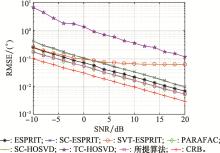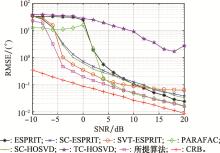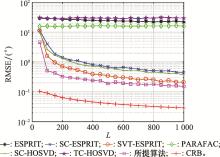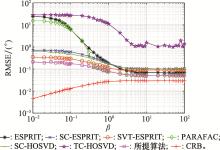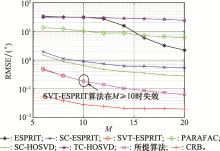Systems Engineering and Electronics ›› 2021, Vol. 43 ›› Issue (6): 1477-1485.doi: 10.12305/j.issn.1001-506X.2021.06.04
• Radar Anti-jamming Technology • Previous Articles Next Articles
Angle estimation for bistatic MIMO radar with spatially colored noise
Junpeng SHI1, Fangqing WEN2,3,*, Lin AI3, Gong ZHANG4, Zhenghui GONG1
- 1. School of Electronic Science and Engineering, National University of Defense Technology, Changsha 410073, China
2. College of Computer and Information Technology, China Three Gorges University, Yichang 443002, China
3. School of Electronics and Information, Yangtze University, Jingzhou 434200, China
4. College of Electronics and Information Engineering, Nanjing University of Aeronautics and Astronautics, Nanjing 210016, China
-
Received:2020-11-16Online:2021-05-21Published:2021-05-28 -
Contact:Fangqing WEN
CLC Number:
Cite this article
Junpeng SHI, Fangqing WEN, Lin AI, Gong ZHANG, Zhenghui GONG. Angle estimation for bistatic MIMO radar with spatially colored noise[J]. Systems Engineering and Electronics, 2021, 43(6): 1477-1485.
share this article
| 1 | FISHLER E, HAIMOVICH A, BLUM R, et al. MIMO radar: an idea whose time has come[C]//Proc. of the IEEE Radar Conference, 2004: 71-78. |
| 2 |
LI J , STOICA P . MIMO radar with colocated antennas[J]. IEEE Signal Processing Magazine, 2007, 24 (5): 106- 114.
doi: 10.1109/MSP.2007.904812 |
| 3 |
HAIMOVICH A , BLUM R , CIMINI L . MIMO radar with widely separated antennas[J]. IEEE Signal Processing Magazine, 2008, 25 (1): 116- 129.
doi: 10.1109/MSP.2008.4408448 |
| 4 | 郑志东, 袁红刚. 非均匀矩形阵列下双基地MIMO雷达目标定位方法[J]. 电子与信息学报, 2018, 40 (8): 1802- 1808. |
| ZHENG Z D , YUAN H G . Multi-target localization method for bistatic MIMO radar using nonuniform rectangular array[J]. Journal of Electronics and Information Technology, 2018, 40 (8): 1802- 1808. | |
| 5 | 程院兵, 吴临江, 郑昱, 等. 基于多维范德蒙德结构的双基地MIMO雷达收发角及多普勒频率联合估计[J]. 电子与信息学报, 2018, 40 (9): 2258- 2264. |
| CHENG Y B , WU L J , ZHENG Y , et al. Multi-dimensional vandermonde structure based DOD-DOA and Doppler frequency estimation for bistatic MIMO radar[J]. Journal of Electronics and Information Technology, 2018, 40 (9): 2258- 2264. | |
| 6 | 徐保庆, 赵永波, 庞晓娇. 基于实值处理的联合波束域双基地MIMO雷达测角算法[J]. 电子与信息学报, 2019, 41 (7): 1721- 1727. |
| XU B Q , ZHAO Y B , PANG X J . Joint real-valued beamspace-based method for angle estimation in bistatic MIMO radar[J]. Journal of Electronics and Information Technology, 2019, 41 (7): 1721- 1727. | |
| 7 |
ZHANG X F , XU L Y , XU L , et al. Direction of departure (DOD) and direction of arrival (DOA) estimation in MIMO radar with reduced-dimension MUSIC[J]. IEEE Communications Letters, 2010, 14 (12): 1161- 1163.
doi: 10.1109/LCOMM.2010.102610.101581 |
| 8 |
CHEN D F , CHEN B X , QIN G D . Angle estimation using ESPRIT in MIMO radar[J]. Electronics Letters, 2008, 44 (12): 770- 771.
doi: 10.1049/el:20080276 |
| 9 |
WANG X P , WANG W , LIU J , et al. A sparse representation scheme for angle estimation in monostatic MIMO radar[J]. Signal Processing, 2014, 104, 258- 263.
doi: 10.1016/j.sigpro.2014.04.007 |
| 10 | ZHANG X F , XU Z , XU L Y , et al. Trilinear decomposition-based transmit angle and receive angle estimation for multiple-input multiple-output radar[J]. IET Radar, Sonar & Navigation, 2011, 5 (6): 626- 631. |
| 11 |
CHENG Y B , YU R S , GU H , et al. Multi-SVD based subspace estimation to improve angle estimation accuracy in bistatic MIMO radar[J]. Signal Processing, 2013, 93 (7): 2003- 2009.
doi: 10.1016/j.sigpro.2012.12.021 |
| 12 | SUN S, PETROPULU A P. On transmit beamforming in MIMO radar with matrix completion[C]//Proc. of the IEEE International Conference on Acoustics, 2015: 2774-2778. |
| 13 |
CHENG Z Y , LIAO B , HE Z S , et al. Spectrally compatible waveform design for MIMO radar in the presence of multiple targets[J]. IEEE Trans.on Signal Processing, 2018, 66 (13): 3543- 3555.
doi: 10.1109/TSP.2018.2833818 |
| 14 |
ZHENG G M . DOA estimation in MIMO radar with non-perfectly orthogonal waveforms[J]. IEEE Communications Letters, 2017, 21 (2): 414- 417.
doi: 10.1109/LCOMM.2016.2622691 |
| 15 |
JIN M , LIAO G S , LI J . Joint DOD and DOA estimation for bistatic MIMO radar[J]. Signal Processing, 2009, 89 (2): 244- 251.
doi: 10.1016/j.sigpro.2008.08.003 |
| 16 |
CHEN J L , GU H , SU W M . A new method for joint DOD and DOA estimation in bistatic MIMO radar[J]. Signal Processing, 2010, 90 (2): 714- 718.
doi: 10.1016/j.sigpro.2009.08.003 |
| 17 |
WANG X P , WANG W , LI X , et al. A tensor-based subspace approach for bistatic MIMO radar in spatial colored noise[J]. Sensors, 2014, 14 (3): 3897- 3907.
doi: 10.3390/s140303897 |
| 18 |
JIANG H , ZHANG J K , WONG K M . Joint DOD and DOA estimation for bistatic MIMO radar in unknown correlated noise[J]. IEEE Trans.on Vehicular Technology, 2015, 64 (11): 5113- 5125.
doi: 10.1109/TVT.2014.2384495 |
| 19 | 符渭波, 苏涛, 赵永波, 等. 空间色噪声环境下基于时空结构的双基地MIMO雷达角度和多普勒频率联合估计方法[J]. 电子与信息学报, 2011, 33 (7): 1649- 1654. |
| FU W B , SU T , ZHAO Y B , et al. Joint estimation of angle and Doppler frequency for bistatic MIMO radar in spatial colored noise based on temporal-spatial structure[J]. Journal of Electronics and Information Technology, 2011, 33 (7): 1649- 1654. | |
| 20 | 符渭波, 苏涛, 赵永波, 等. 空间色噪声环境下双基地MIMO雷达角度和多普勒频率联合估计方法[J]. 电子与信息学报, 2011, 33 (12): 2858- 2862. |
| FU W B , SU T , ZHAO Y B , et al. Joint estimation of angle and Doppler frequency for bistatic MIMO radar in spatial colored noise[J]. Journal of Electronics and Information Technology, 2011, 33 (12): 2858- 2862. | |
| 21 |
WEN F Q , XIONG X D , SU J , et al. Angle estimation for bistatic MIMO radar in the presence of spatial colored noise[J]. Signal Processing, 2017, 134, 261- 267.
doi: 10.1016/j.sigpro.2016.12.017 |
| 22 | HONG S , WAN X R , CHENG F , et al. Covariance differencing-based matrix decomposition for coherent sources localization in bi-static multiple-input multiple-output radar[J]. IET Radar, Sonar & Navigation, 2015, 9 (5): 540- 549. |
| 23 | 宫健, 楼顺天, 郭艺夺, 等. 色噪声背景下相干信源的MIMO雷达超分辨测向算法[J]. 现代雷达, 2018, 40 (1): 25- 29. |
| GONG J , LOU S T , GUO Y D , et al. Super-resolution direction finding algorithm to coherent signals for MIMO radar in the presence of colored noise[J]. Modern Radar, 2018, 40 (1): 25- 29. | |
| 24 |
王彩云, 龚珞珞, 吴淑侠. 色噪声下双基地MIMO雷达DOD和DOA联合估计[J]. 系统工程与电子技术, 2015, 37 (10): 2255- 2259.
doi: 10.3969/j.issn.1001506X.2015.10.10 |
|
WANG C Y , GONG L L , WU S X . Joint DOD and DOA estimation for bistatic MIMO radar in the presence of colored noise[J]. Systems Engineering and Electronics, 2015, 37 (10): 2255- 2259.
doi: 10.3969/j.issn.1001506X.2015.10.10 |
|
| 25 | LIAO B . Fast angle estimation for MIMO radar with nonorthogonal waveforms[J]. IEEE Trans.on Aerospace & Electronic Systems, 2018, 54 (4): 2091- 2096. |
| 26 |
WEN F Q , SHI J P , ZHANG Z J . Direction finding for bistatic MIMO radar with unknown spatially colored noise[J]. Circuits, Systems, and Signal Processing, 2020, 39, 2412- 2424.
doi: 10.1007/s00034-019-01260-5 |
| 27 |
CAI J F , CANDES E J , SHEN Z . A singular value thresholding algorithm for matrix completion[J]. SIAM Journal on Optimization, 2008, 20 (4): 1956- 1982.
doi: 10.1007/s00041-019-09688-8 |
| 28 |
LIU J , MUSIALSKI P , WONKA P , et al. Tensor completion for estimating missing values in visual data[J]. IEEE Trans.on Pattern Analysis and Machine Intelligence, 2013, 35 (1): 208- 220.
doi: 10.1109/TPAMI.2012.39 |
| 29 |
KOLDA T G , BADER B W . Tensor decompositions and applications[J]. SIAM Review, 2009, 51 (3): 455- 500.
doi: 10.1137/07070111X |
| 30 | RAO W , LI D , ZHANG J Q . A tensor-based approach to L-shaped arrays processing with enhanced degrees of freedom[J]. IEEE Signal Processing Letters, 2018, 25 (2): 234- 238. |
| 31 |
NION D , SIDIROPOULOS N D . Tensor algebra and multidimensional harmonic retrieval in signal processing for MIMO radar[J]. IEEE Trans.on Signal Processing, 2010, 58 (11): 5693- 5705.
doi: 10.1109/TSP.2010.2058802 |
| 32 | BRO R, SIDIROPOULOS N, GIANNAKIS G. A fast least squares algorithm for separating trilinear mixtures[C]//Proc. of the International Workshop on Independent Component Analysis and Blind Signal Separation, 1999: 11-15. |
| 33 | SHI J P , WEN F Q , LIU T P . Nested MIMO radar: coarrays, tensor modeling and angle estimation[J]. IEEE Trans.on Aerospace Electronic Systerm, 2021, 57 (1): 573- 585. |
| 34 | WEN F Q , ZHANG Z J , ZHANG X Y . CRBs for direction-of-departure and direction-of-arrival estimation in collocated MIMO radar in the presence of unknown spatially coloured noise[J]. IET Radar, Sonar & Navigation, 2019, 13 (4): 530- 537. |
| [1] | Yuzhuo WANG, Shengqi ZHU, Ximin LI, Lan LAN. Range ambiguous clutter suppression for FDA MIMO bistatic radar with main lobe correction [J]. Systems Engineering and Electronics, 2022, 44(5): 1483-1494. |
| [2] | Sheng CHEN, Yongbo ZHAO, Xiaojiao PANG, Yili HU, Chenghu CAO. Beam space refined maximum likelihood algorithm for VHF MIMO radar [J]. Systems Engineering and Electronics, 2022, 44(5): 1520-1526. |
| [3] | Xiaotong ZHAO, Jianjiang ZHOU. Improved MUSIC algorithm for MIMO radar with low intercept [J]. Systems Engineering and Electronics, 2022, 44(2): 490-497. |
| [4] | Junkui TANG, Zheng LIU, Rong XIE, Bo ZENG. Optimal design method for sparse array of MIMO radar [J]. Systems Engineering and Electronics, 2022, 44(12): 3661-3666. |
| [5] | Zhiyuan YOU, Guoping HU, Hao ZHOU. Bistatic nested MIMO radar based on redundant element optimization joint estimation method of target DOD and DOA [J]. Systems Engineering and Electronics, 2022, 44(12): 3696-3702. |
| [6] | Yang ZHANG, Yinsheng WEI, Lei YU. Joint suppression method of mainlobe multiple false targets jamming transceriver [J]. Systems Engineering and Electronics, 2021, 43(6): 1486-1496. |
| [7] | Tao PU, Ningning TONG, Weike FENG, Liang FANG, Xiaoyang GAO. Extended target high resolution imaging algorithm for MIMO radar based on block sparse matrix recovery [J]. Systems Engineering and Electronics, 2021, 43(3): 647-655. |
| [8] | Chunqi JIANG, Na'e ZHENG, Zong ZUO, Sheng WANG, Xiang CHEN. Antenna selection of distributed MIMO radar on target tracking with key target highlighted [J]. Systems Engineering and Electronics, 2021, 43(10): 2860-2868. |
| [9] | Zhengjie LI, Junwei XIE, Haowei ZHANG, Zhaojian ZHANG. Joint power and bandwidth allocation algorithm based on collocated MIMO radar [J]. Systems Engineering and Electronics, 2020, 42(5): 1041-1049. |
| [10] | ZHANG Bo, DAI Fengzhou, FENG Dazheng. Transmit beampattern design for conformal MIMO radar based on virtual aperture projection [J]. Systems Engineering and Electronics, 2019, 41(7): 1489-1495. |
| [11] | PANG Yucai, LIU Song. Optimization of MIMO radar sparse array based on modified artificial bee colony [J]. Systems Engineering and Electronics, 2018, 40(5): 1026-1030. |
| [12] | YANG Kang, WEN Fangqing, HUANG Dongmei, ZHANG Lei, WANG Ke. Real-value-based trilinear decomposition based direction estimation algorithm for bistatic MIMO radar in the presence of mutual coupling [J]. Systems Engineering and Electronics, 2018, 40(2): 314-321. |
| [13] | XU Yizheng, LIAO Guisheng, XU Jingwei, WANG Chenghao. Range ambiguous clutter suppression based on forward looking FDA-MIMO radar [J]. Systems Engineering and Electronics, 2018, 40(12): 2662-2667. |
| [14] | YANG Shouguo, LI Yong, ZHANG Kunhui, GUO Yiduo. Reduced dimensional calibration method for bistatic MIMO radar with mutual coupling and gain phase errors of transmitting and receiving arrays#br# [J]. Systems Engineering and Electronics, 2018, 40(12): 2668-2674. |
| [15] | ZHANG Min, LI Zonghao, GAO Ming. Design and performance of MIMO radar signal based on Lorenz chaos [J]. Systems Engineering and Electronics, 2018, 40(1): 58-64. |
| Viewed | ||||||
|
Full text |
|
|||||
|
Abstract |
|
|||||
